[English] 日本語
 Yorodumi
Yorodumi- PDB-1ias: CYTOPLASMIC DOMAIN OF UNPHOSPHORYLATED TYPE I TGF-BETA RECEPTOR C... -
+ Open data
Open data
- Basic information
Basic information
| Entry | Database: PDB / ID: 1ias | ||||||
|---|---|---|---|---|---|---|---|
| Title | CYTOPLASMIC DOMAIN OF UNPHOSPHORYLATED TYPE I TGF-BETA RECEPTOR CRYSTALLIZED WITHOUT FKBP12 | ||||||
 Components Components | TGF-BETA RECEPTOR TYPE I | ||||||
 Keywords Keywords | TRANSFERASE / kinase / TGF-beta receptor / GS region | ||||||
| Function / homology |  Function and homology information Function and homology informationextracellular structure organization / epicardium morphogenesis / vascular endothelial cell proliferation / parathyroid gland development / transforming growth factor beta ligand-receptor complex / regulation of cardiac muscle cell proliferation / myofibroblast differentiation / positive regulation of epithelial to mesenchymal transition involved in endocardial cushion formation / TGFBR2 Kinase Domain Mutants in Cancer / transforming growth factor beta receptor activity ...extracellular structure organization / epicardium morphogenesis / vascular endothelial cell proliferation / parathyroid gland development / transforming growth factor beta ligand-receptor complex / regulation of cardiac muscle cell proliferation / myofibroblast differentiation / positive regulation of epithelial to mesenchymal transition involved in endocardial cushion formation / TGFBR2 Kinase Domain Mutants in Cancer / transforming growth factor beta receptor activity / trophoblast cell migration / angiogenesis involved in coronary vascular morphogenesis / SMAD2/3 Phosphorylation Motif Mutants in Cancer / TGFBR1 KD Mutants in Cancer / positive regulation of mesenchymal stem cell proliferation / ventricular compact myocardium morphogenesis / positive regulation of extracellular matrix assembly / positive regulation of tight junction disassembly / cardiac epithelial to mesenchymal transition / mesenchymal cell differentiation / TGFBR3 regulates TGF-beta signaling / transforming growth factor beta receptor activity, type I / positive regulation of vasculature development / neuron fate commitment / activin receptor complex / activin receptor activity, type I / regulation of epithelial to mesenchymal transition / type II transforming growth factor beta receptor binding / pharyngeal system development / transmembrane receptor protein serine/threonine kinase activity / receptor protein serine/threonine kinase / activin binding / TGFBR1 LBD Mutants in Cancer / germ cell migration / filopodium assembly / coronary artery morphogenesis / embryonic cranial skeleton morphogenesis / activin receptor signaling pathway / ventricular trabecula myocardium morphogenesis / response to cholesterol / I-SMAD binding / transforming growth factor beta binding / collagen fibril organization / negative regulation of chondrocyte differentiation / lens development in camera-type eye / endothelial cell activation / anterior/posterior pattern specification / positive regulation of filopodium assembly / artery morphogenesis / skeletal system morphogenesis / ventricular septum morphogenesis / SMAD binding / negative regulation of endothelial cell proliferation / roof of mouth development / TGF-beta receptor signaling activates SMADs / positive regulation of SMAD protein signal transduction / epithelial to mesenchymal transition / blastocyst development / regulation of protein ubiquitination / bicellular tight junction / cellular response to transforming growth factor beta stimulus / endothelial cell migration / positive regulation of epithelial to mesenchymal transition / positive regulation of stress fiber assembly / positive regulation of endothelial cell proliferation / transforming growth factor beta receptor signaling pathway / negative regulation of cell migration / thymus development / Downregulation of TGF-beta receptor signaling / positive regulation of apoptotic signaling pathway / TGF-beta receptor signaling in EMT (epithelial to mesenchymal transition) / skeletal system development / post-embryonic development / negative regulation of extrinsic apoptotic signaling pathway / kidney development / cell motility / wound healing / peptidyl-serine phosphorylation / cellular response to growth factor stimulus / male gonad development / UCH proteinases / nervous system development / heart development / regulation of gene expression / positive regulation of cell growth / in utero embryonic development / positive regulation of phosphatidylinositol 3-kinase/protein kinase B signal transduction / protein kinase activity / receptor complex / endosome / regulation of cell cycle / Ub-specific processing proteases / intracellular signal transduction / cilium / positive regulation of cell migration / membrane raft / protein serine/threonine kinase activity / positive regulation of cell population proliferation / apoptotic process / ubiquitin protein ligase binding Similarity search - Function | ||||||
| Biological species |  Homo sapiens (human) Homo sapiens (human) | ||||||
| Method |  X-RAY DIFFRACTION / X-RAY DIFFRACTION /  SYNCHROTRON / SYNCHROTRON /  MOLECULAR REPLACEMENT / Resolution: 2.9 Å MOLECULAR REPLACEMENT / Resolution: 2.9 Å | ||||||
 Authors Authors | Huse, M. / Muir, T.W. / Chen, Y.-G. / Kuriyan, J. / Massague, J. | ||||||
 Citation Citation |  Journal: Mol.Cell / Year: 2001 Journal: Mol.Cell / Year: 2001Title: The TGF beta receptor activation process: an inhibitor- to substrate-binding switch. Authors: Huse, M. / Muir, T.W. / Xu, L. / Chen, Y.G. / Kuriyan, J. / Massague, J. | ||||||
| History |
|
- Structure visualization
Structure visualization
| Structure viewer | Molecule:  Molmil Molmil Jmol/JSmol Jmol/JSmol |
|---|
- Downloads & links
Downloads & links
- Download
Download
| PDBx/mmCIF format |  1ias.cif.gz 1ias.cif.gz | 324.2 KB | Display |  PDBx/mmCIF format PDBx/mmCIF format |
|---|---|---|---|---|
| PDB format |  pdb1ias.ent.gz pdb1ias.ent.gz | 268 KB | Display |  PDB format PDB format |
| PDBx/mmJSON format |  1ias.json.gz 1ias.json.gz | Tree view |  PDBx/mmJSON format PDBx/mmJSON format | |
| Others |  Other downloads Other downloads |
-Validation report
| Summary document |  1ias_validation.pdf.gz 1ias_validation.pdf.gz | 490.6 KB | Display |  wwPDB validaton report wwPDB validaton report |
|---|---|---|---|---|
| Full document |  1ias_full_validation.pdf.gz 1ias_full_validation.pdf.gz | 559 KB | Display | |
| Data in XML |  1ias_validation.xml.gz 1ias_validation.xml.gz | 64 KB | Display | |
| Data in CIF |  1ias_validation.cif.gz 1ias_validation.cif.gz | 86 KB | Display | |
| Arichive directory |  https://data.pdbj.org/pub/pdb/validation_reports/ia/1ias https://data.pdbj.org/pub/pdb/validation_reports/ia/1ias ftp://data.pdbj.org/pub/pdb/validation_reports/ia/1ias ftp://data.pdbj.org/pub/pdb/validation_reports/ia/1ias | HTTPS FTP |
-Related structure data
| Related structure data | |
|---|---|
| Similar structure data |
- Links
Links
- Assembly
Assembly
| Deposited unit | 
| ||||||||
|---|---|---|---|---|---|---|---|---|---|
| 1 |
| ||||||||
| Unit cell |
|
- Components
Components
| #1: Protein | Mass: 38920.641 Da / Num. of mol.: 5 / Fragment: CYTOPLASMIC DOMAIN (RESIDUES 162-503) Source method: isolated from a genetically manipulated source Source: (gene. exp.)  Homo sapiens (human) / Production host: Homo sapiens (human) / Production host:  #2: Chemical | ChemComp-SO4 / |
|---|
-Experimental details
-Experiment
| Experiment | Method:  X-RAY DIFFRACTION / Number of used crystals: 1 X-RAY DIFFRACTION / Number of used crystals: 1 |
|---|
- Sample preparation
Sample preparation
| Crystal | Density Matthews: 3.91 Å3/Da / Density % sol: 68.54 % Description: While TbR-I does crystallize in the absence of FKBP12, the crystals diffract poorly and are difficult to handle. To circumvent this problem, we sought high affinity, small molecule ...Description: While TbR-I does crystallize in the absence of FKBP12, the crystals diffract poorly and are difficult to handle. To circumvent this problem, we sought high affinity, small molecule inhibitors that might stabilize TbR-I and thereby allow growth of better crystals. High affinity inhibitors of this class of kinases are not widely available in the public domain. We were provided with a quinazoline derivative that specifically inhibits TbR-I with an IC50 significantly less than 10mM (NPC-30345, proprietary to Scios, Inc., a company not affiliated with any of the authors). Addition of NPC-30345 allows the TbR-I crystals to grow larger and to diffract X-rays to moderate resolution using synchrotron sources. It is not possible to build a detailed molecular model for the inhibitor at the resolution of the analysis without knowledge of its precise chemical structure, which is proprietary to Scios, Inc. As such, we have not included a model for the inhibitor in the refinement. Electron density maps calculated using structure factors (deposited) and the model allow visualization of density for the inhibitor. | |||||||||||||||
|---|---|---|---|---|---|---|---|---|---|---|---|---|---|---|---|---|
| Crystal grow | Temperature: 277 K / Method: vapor diffusion, hanging drop / pH: 5.8 Details: 100 mM MES pH 5.8, 2.4 M ammonium sulfate, 10 % glycerol v/v, 150 mM NaCl, 1 mM NPC-30345, VAPOR DIFFUSION, HANGING DROP, temperature 277K | |||||||||||||||
| Crystal | *PLUS Density % sol: 70 % | |||||||||||||||
| Crystal grow | *PLUS Temperature: 4 ℃ / Method: vapor diffusion / PH range low: 5.8 / PH range high: 5.7 | |||||||||||||||
| Components of the solutions | *PLUS
|
-Data collection
| Diffraction | Mean temperature: 100 K |
|---|---|
| Diffraction source | Source:  SYNCHROTRON / Site: SYNCHROTRON / Site:  CHESS CHESS  / Beamline: F1 / Wavelength: 0.948 Å / Beamline: F1 / Wavelength: 0.948 Å |
| Detector | Type: ADSC QUANTUM 4 / Detector: CCD / Date: Jan 27, 2001 |
| Radiation | Monochromator: Si 111 CHANNEL / Protocol: SINGLE WAVELENGTH / Monochromatic (M) / Laue (L): M / Scattering type: x-ray |
| Radiation wavelength | Wavelength: 0.948 Å / Relative weight: 1 |
| Reflection | Resolution: 2.9→50 Å / Num. all: 66462 / Num. obs: 59616 / % possible obs: 89.7 % / Observed criterion σ(F): 0 / Observed criterion σ(I): 0 / Redundancy: 4.3 % / Biso Wilson estimate: 57.4 Å2 / Rmerge(I) obs: 0.08 / Rsym value: 0.08 / Net I/σ(I): 22 |
| Reflection shell | Resolution: 2.9→30 Å / Redundancy: 2.7 % / Rmerge(I) obs: 0.312 / Mean I/σ(I) obs: 3.5 / Num. unique all: 2677 / Rsym value: 0.312 / % possible all: 61 |
| Reflection | *PLUS Lowest resolution: 50 Å / Rmerge(I) obs: 0.08 |
| Reflection shell | *PLUS % possible obs: 61.1 % |
- Processing
Processing
| Software |
| |||||||||||||||||||||||||
|---|---|---|---|---|---|---|---|---|---|---|---|---|---|---|---|---|---|---|---|---|---|---|---|---|---|---|
| Refinement | Method to determine structure:  MOLECULAR REPLACEMENT MOLECULAR REPLACEMENTStarting model: TGF-beta receptor from TGF-beta receptor/FKBP12 structure Resolution: 2.9→30 Å / Cross valid method: FREE R-VALUE / σ(F): 0 / σ(I): 0 / Stereochemistry target values: Engh & Huber
| |||||||||||||||||||||||||
| Displacement parameters | Biso mean: 68.8 Å2
| |||||||||||||||||||||||||
| Refine analyze |
| |||||||||||||||||||||||||
| Refinement step | Cycle: LAST / Resolution: 2.9→30 Å
| |||||||||||||||||||||||||
| Refine LS restraints |
| |||||||||||||||||||||||||
| Software | *PLUS Name: CNS / Classification: refinement | |||||||||||||||||||||||||
| Refinement | *PLUS Highest resolution: 2.9 Å / Lowest resolution: 30 Å / σ(F): 0 / % reflection Rfree: 10 % | |||||||||||||||||||||||||
| Solvent computation | *PLUS | |||||||||||||||||||||||||
| Displacement parameters | *PLUS Biso mean: 68.8 Å2 | |||||||||||||||||||||||||
| Refine LS restraints | *PLUS
|
 Movie
Movie Controller
Controller



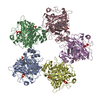
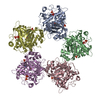
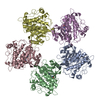
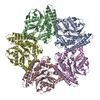
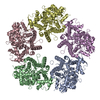

 PDBj
PDBj





